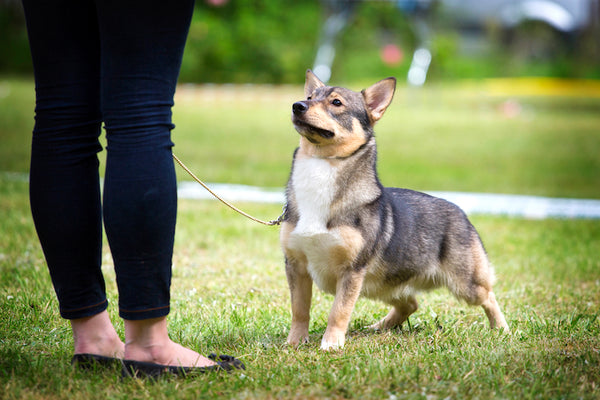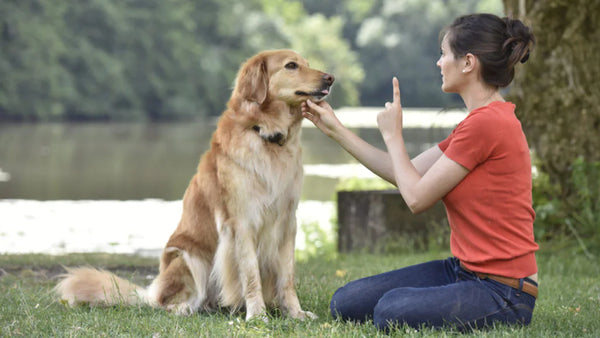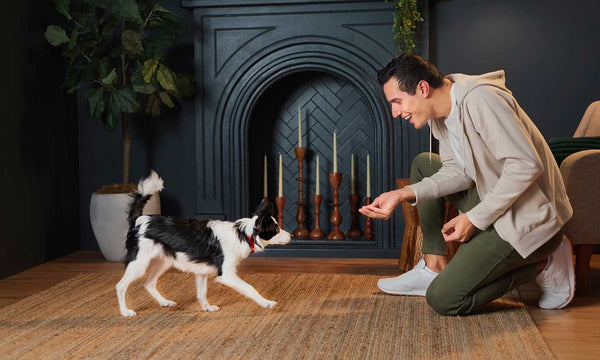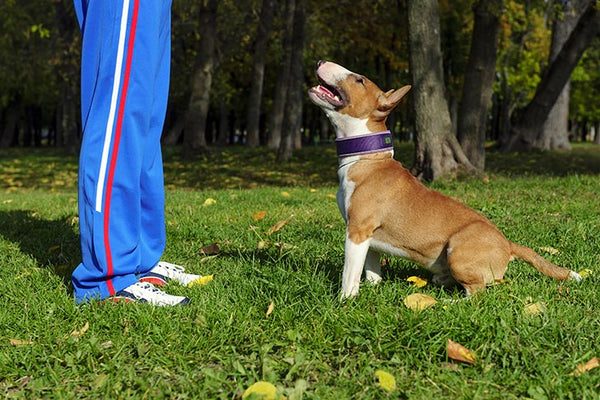Would you like to see the top 10 most essential commands every dog should know? Basic dog training is necessary to stimulate your dog mentally and teach them discipline. Do dogs like learning?
Dogs love:
- Spending time with their owner,
- Being productive,
- Having a purpose.
Dogs enjoy the learning process if their owner is entertaining and gives them plenty of treats. Training isn't useful just for your dog, but also for you! It will enable you to form a special bond with your dog and make spending time with your pet more enjoyable.
Now let's take a look at the top 10 most essential commands every dog should know:
10.Stand.
Teaching your dog the "stand" command doesn't require any special techniques.You need only treats that will entice your dog to get up from their sitting or lying down position.
How to teach your dog to get up?
1.Start with your dog sitting or lying down.
2.Grab a dog treat and move it closer to your dog's nose.
3. Say the command: "stand."
4.Move the dog treat out of reach, and your dog should get up.
5.Repeat the previous steps.
The dog should learn the "stand" command if you make sure to repeat the training for a few days.It allows a bit more control over your dog and is very practical with energetic and playful dogs in particular.

9.Give Paw or Shake.
Give Paw (or Shake) is another one of the basic commands almost every dog owner tries out with their pet. Still, why not go a step further? You can teach your dog to give you one paw, and after that, give the other one!
How to teach your dog to give their paw?
1.Place a dog treat in your hand, then close it.
2.Move your hand closer to the dog so they can smell the dog treat.
3.Your dog should eventually try reaching for it with their paw (an instinctive reaction when they can't get to something).
4.Reward your dog even for a slight paw shake.
5.Repeat these steps a few times.
6.Add the "give paw" command before you move in with the dog treat.
When your dog starts giving you their paw, feel free to add the "give the other paw” command.The next step is a brand new, yet quite similar command. What is it? The "give me five" command is even more fun, and I warmly recommend you try learning it with your pet!

8.Leave It.
The "leave it" command is a bit more challenging. There are three parts to it. Still, with the right approach, you shouldn't have any problems teaching your dog the “leave it" command. How to teach your dog to "leave it"?
In the first part of the training, you should:
1.Place a dog treat in your hand, then close it.
2.Let your dog smell the dog treat and say the "leave it" command.
3.Once the dog stops paying attention to your hand, reward them, and praise them.
4.Repeat the previous steps a few times. Once your dog learns the command, you can proceed to a more challenging form of training. This command is supposed to prevent the dog from interacting with a particular object, person, or another animal.
In the second part of the training, you should:
1.Place dog treats in both hands.
2.Offer one of them to your dog and tell them to leave it.
3.Once the dog stops paying attention, reward them with the dog treat from your other hand.
4.Repeat a few times.
The third part consists of the same steps, but place one of the dog treats or toys on the floor instead of holding it. This command shows its worth during walks, but also with other behavioral problems dog owners often encounter.
Puppies especially love sniffing, licking, and chewing on anything they come across.

7.With Me.
The "with me" command is useful during walks. More specifically, your dog should come to you and sit down next to your left leg. How to teach your dog the "with me" command? The first part of training:
1.Your dog should be in front of you.
2.Place a dog treat in your hand and let the dog smell it, then say the "with me" command.
3.Slowly move the dog treat to entice your dog to come to your left leg and sit down (you don't have to insist on sitting right away).
4.Once the dog has done what you asked of them, reward them, and praise them.
5.Repeat the previous steps.
Once your dog learns the command, move on to the advanced part of the training.
The second part of training:
1.Place your dog next to your left leg.
2.Walk at a slow speed and repeat the "with me" command every few seconds.
3.Once the dog does what you want them to, reward them with a dog treat and praise them.
4.Repeat the previous steps.The "with me" command is one of the most essential for dog walking.I advise you to teach it to your dog before going out on a walk.Every time your dog wanders off, this command will prove to be very useful in keeping them next to you.

6.Speak and Quiet.
These commands are very desirable for dog breeds prone to barking. When you have a dog who barks often, it's remarkably easy to teach them the “speak" command.
How to teach your dog the "speak" command?
1.When the dog is barking, say "speak."
2.If your dog barks again, reward them and praise them.
3.Repeat the previous steps a few times.
Once your dog understands the "speak" command, you can begin teaching them “quiet." How to teach your dog the "quiet" command?
1.Tell your dog to "speak."Praise them.
2.Say the "speak" command again.
3.As your dog is barking, say "quiet" with a louder tone of voice to attract your dog’s attention.
4.Once the dog stops barking, reward with a dog treat and praise.
5.Repeat the previous steps.
I advise changing up the number of times you say the "speak" command before saying “quiet" to keep the dog motivated.

5.Come.
"Come" is one of the most vital dog commands. It's crucial to ensure your dog doesn't associate it with a bad experience. How to teach your dog the "come" command?
1.Put your dog on a leash.
2.Take a dog treat and say the "come" command.
3.If your dog isn't coming, you can gently pull on the leash.
4.Once the dog arrives, give them the treat.
5.Repeat the previous steps.Make sure your dog associates the "come" command with good things by teaching it with rewards such as:
• Toys.
• Playing in the yard.
• Cuddling.
• Mealtime.

4. Stay.
Your dog will have an easier time learning the "stay" command if you train them gradually. What do I mean by this? Reward your dog for waiting two seconds, then gradually introduce more prolonged periods. How to teach your dog to "stay"?
1.Your dog should be sitting.
2.Give your dog the "stay" command, and reinforce it with a non-verbal hand sign (place your hand in front of their head).
3.Repeat the previous steps while gradually increasing the amount of waiting time.
To make training more challenging, once your dog has learned the command, try to move further away from them.Again, do it gradually - start with one step away, then increase the distance.

3. Lie Down.
The "lie down" command is a challenging one and will require multiple repeats. Still, by using a simple trick, you shouldn't have much trouble training this command with your pet. What's the trick? Dog treats that attract their attention and entice them to lie down. How to train your dog to "lie down"?
1.Ideally, the dog should be sitting.
2.Grab a dog treat and let your dog smell it.
3.Slowly move the dog treat toward the floor.
4.Your dog should follow the dog treat and lie down.Reward them even if they're very close to lying down.
5.Once the dog lies down, reward and praise your dog.
6.Repeat the previous steps and add the "lie down" command when your dog smells a dog treat.
Be patient with this command.It's a good idea to award a dog treat as soon as your dog starts moving toward the floor, even without completely lying down. Dogs are smart creatures, and will quickly learn the command once they realize that moving toward the floor is a good thing.

2. Sit.
We all know "sit" as one of the most basic commands, but do we understand why it's so useful? Distraction is one of the best methods to prevent your dog's unwanted behaviors. The "sit" command is one of the best and most useful commands for distracting dogs during a walk.
It is especially useful when your dog: • Sees other dogs and is showing signs of aggression,
• Jumps on people during a walk,
• Is learning to walk on a leash.
The "sit" command is also useful for training other ones.Dogs can learn to sit with relative ease at an early age, starting from about seven weeks old. How to train your dog to sit?
1.Place a dog treat in your hand and let your dog smell it.
2.Slowly move your hand closer and raise it a little. The dog should react by sitting down.
3.Once the dog sits down, reward with the dog treat.
4.Repeat these steps while adding the "sit" command.
The amount of repetition necessary will depend on the individual dog.
In just a few moments, you will see the most fundamental command that every dog should know.

1.Watch Me.
"Watch Me" is the fundamental command for keeping your dog's attention.
Before each training session, as well as when your dog loses focus, this command will prove itself very useful.
The command is also simple to teach. Dogs will always pay attention to a dog treat! Knowing that a dog will always look in the direction of a dog treat should also help you while teaching them other commands. How to teach your dog the "watch me" command?
1.Grab a dog treat.
2.Place the dog treat close to your dog's nose so they can smell it.
3.Say "watch me" and slowly move the dog treat closer to your face.
4.Reward your dog for good behavior.
5.Repeat the previous steps.
Many dog owners forget to teach their dog this command, which can make attracting the dog's attention much more challenging.
This article's goal has been to show some of the most important commands for basic dog training.Basic dog training comprises fundamental commands that should assist you in all kinds of situations in the future.

